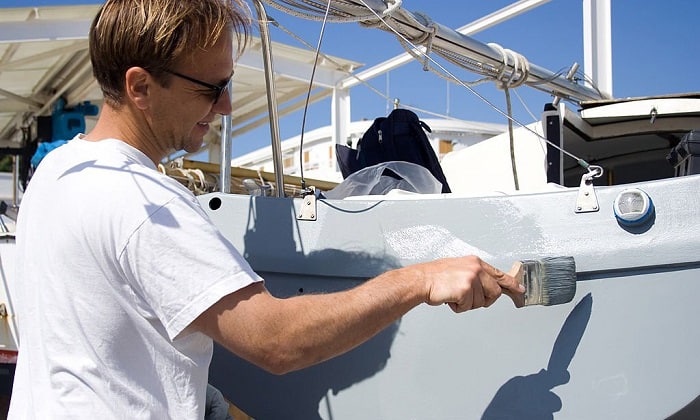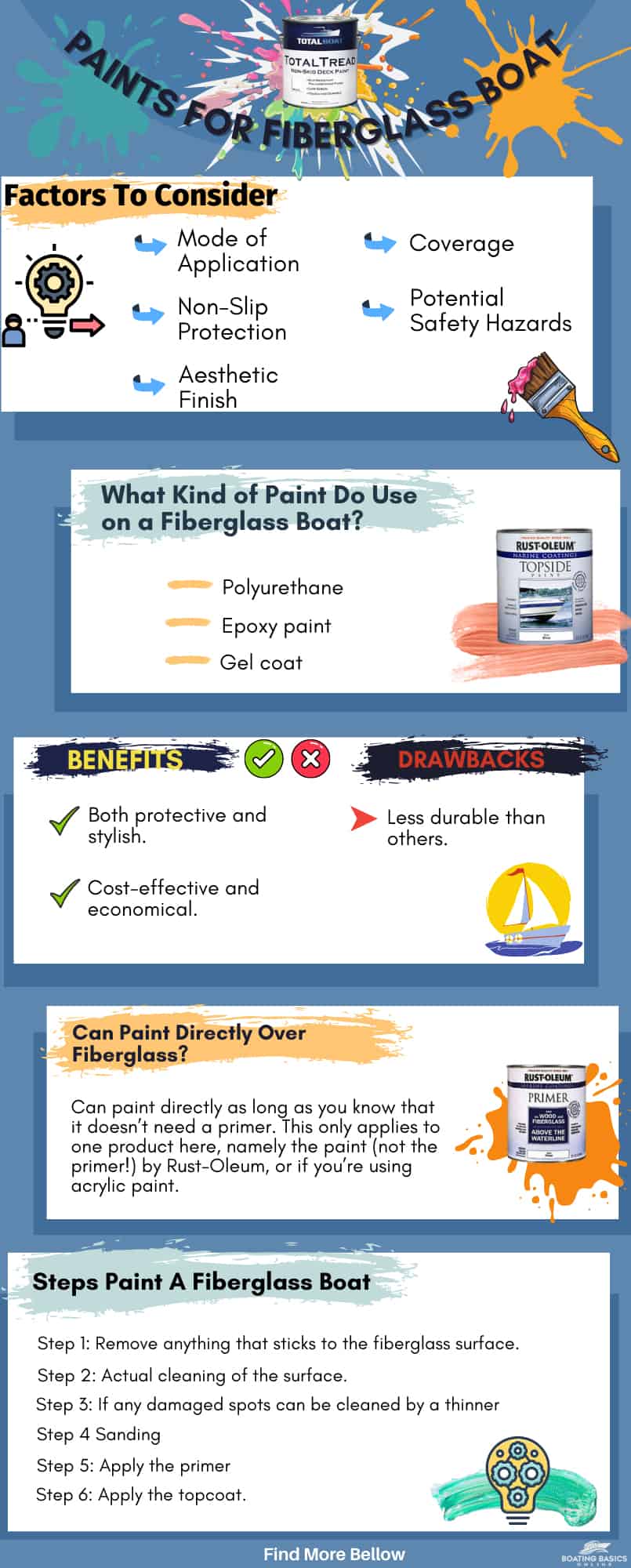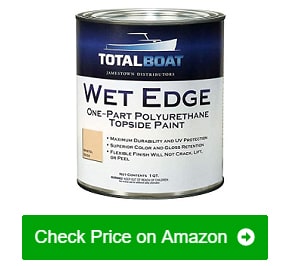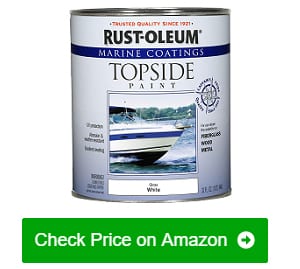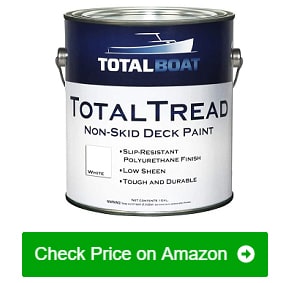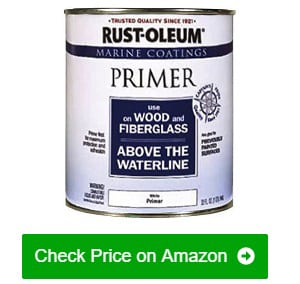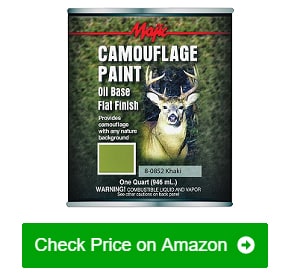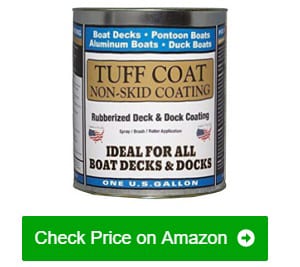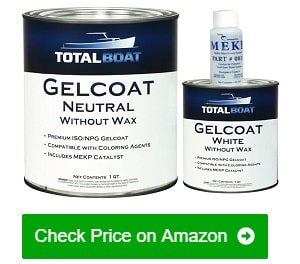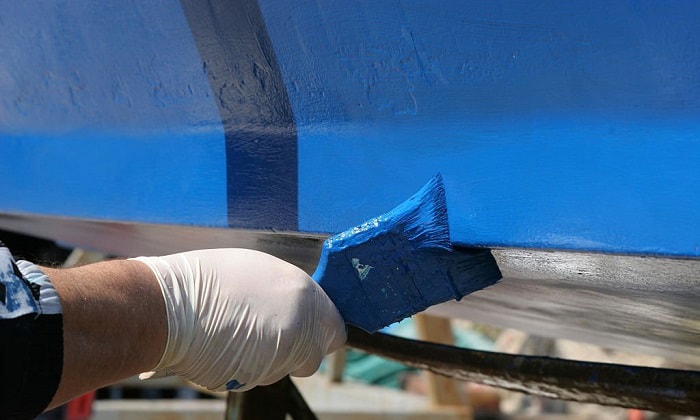If you’re still re-evaluating the paint to use on your fiberglass boat, good move. Boat paint may seem like a mundane factor to the uninformed, but using the wrong one may only lead to regrets later on. The best paint for fiberglass boat should spare you from all that trouble.
In most cases, non-skid paint is a safe option for painting over the gel coat. Some owners consider painting over the gel coat as sacrilege, opting instead to buff it, which is fine. However, I’ve found that many products can be just as good as the original gel coat and last as long.
That being said, prep work is often the deciding factor. You just can’t rush an amazing finish, and I can say as much for most of the marine paint for fiberglass products I’ve featured here. Just be sure you’re actually working with reliable paint before you do elbow grease.
Here are three big factors I like to look at when I’m checking out any product:
- Durability and Longevity: I’m constantly aiming for paint that can last for the average 10 years they’re intended to last. Gel coat is a safe option since it’s naturally made to last, so are a couple of marine topside paints out there that have a feature like superior gloss retention, making the finish easy to clean.
- Obviously, you can always rely on a good primer to bump the longevity up a few years or limit the finish’s exposure to the elements. Take note that paint for a fiberglass boat bottom typically lasts only two years before a repaint is necessary because of marine growth or corrosion.
- Protective Capability: It has to impart protection against mildew, dirt, UV rays, salt water, moisture, abrasions, and other forms of growth and damage that may arise from frequent exposure to extreme marine environments. Marine paint and gel coats anticipate this by being waterproof, UV resistant, mildew resistant, dirt resistant, etc.
- Ease of Application: It’s a given that almost any painting job costs a lot, effort- and money-wise. Prep work is a must, after all, if you want a finish that will be of high quality. Because of this, I prefer paint that’s not difficult to apply.
For instance, I’d like it if I didn’t have to use binders and hardeners just to aid in adhesion and drying. Moreover, I’m a huge fan of it that doesn’t require a primer since it significantly cuts the waiting (and, hence, working) time. I admit that not using a primer can be tricky on fiberglass. Still, it’s not impossible with some of the products featured here.
Self-leveling paint and those that aren’t hard to thin always have often-overlooked perks that help save time and effort.
- Smooth-flowing paint
- Decent non-skid feature
- Fade, scratch, and mildew resistant
- Proven longevity
- Great self-leveling
- Doesn’t require a primer
Table of Contents
- Top 7 Paint for Fiberglass Boat Reviews
- 1. TotalBoat 365393 Wet Edge Marine Topside Paint
- 2. Rust-Oleum 206999 Marine Topside Paint
- 3. TotalBoat TB-TREADWG Non-Skid Deck Paint
- 4. Rust-Oleum 207014 Marine Wood and Fiberglass Primer
- 5. Majic Paints 8-0852-2 Camouflage Paint
- 6. TUFF Coat SR Smooth Texture 1 Gallon Non-Skid Coating
- 7. TotalBoat Marine Gel Coat
- Other Factors To Consider When Buying Paint For Fiberglass Boat
- Can You Paint Directly Over Fiberglass
- How To Paint A Fiberglass Boat
- Do I Need To Sand Fiberglass Boats Before Painting
- Conclusion
Top 7 Paint for Fiberglass Boat Reviews
1. TotalBoat 365393 Wet Edge Marine Topside Paint
This paint is as long-lasting as gel coat, flows smoothly, and imparts a highly protective glossy finish. All the essentials rolled into one, in short.
I’ve heard sailors heap praises on polyurethane paint. My cousin, a fellow boater, suggested this to me because I wanted something that could be as durable as the original gel coat on our family boat. It’s been with us for over 15 years and badly needed a good refurbishing.
All I can say is thank you cousin, indeed, because we did the paint job a whopping nine years ago. The glossy finish is still there, and there’s no evident sign of cracking or scratches. Even mildew and dirt rarely reared their undesirable heads, and if they did, we’re almost always one step ahead of them in the cleaning anyway.
We settled for three coats and followed the xylene recommendation for thinning and also used the brand’s primer. Sanding with 180-grit sandpaper then cleaning with a tack rag made up the majority of the prep work. Don’t skip the cleaning, and I recommend you use oxtail brushes when applying because you want to go for extra-soft bristles as much as possible.
We timed the painting on a warm summer day, with over 85 degrees. We painted using the oxtails, and we instantly loved how the paint flowed smoothly. The result was an attractive glossy (but not overly so) finish, adequately thick, and non-slip for our family sailboat, Lucy Loo.
- Smooth-flowing paint
- Fade, dirt, scratch, and mildew resistant
- Lasts almost as long as an average gel coat
- Decent non-skid feature
- Requires xylene as a thinner
2. Rust-Oleum 206999 Marine Topside Paint
This paint always brings its A-game when it comes to painting anything made of fiberglass. There’s really no better way to describe it than the quintessential marine paint due to its stellar durability rain or shine. It’s also a breeze to roll.
As much as possible, I stick to this product when painting a fiberglass boat because it’s hard to find any other paint that I 100% know works well for this specific material. I like that I don’t need to prime it when I use it on my vessels and the ones I service from time to time. I stick to four coats because they ensure a far more excellent finish, and it’s still going strong and does not have that usual worn-out look in old paint after seven years.
It goes on well with great adhesion. Almost any sailor wants a smooth, even finish on any fiberglass boat’s bottom or deck. This paint self-levels and retains its gloss extremely well, and naturally, both factors sealed the deal for me. And the icing on the cake is that I don’t need a primer at all with this paint.
Don’t skip the sanding, though. Also, if you have time, I suggest you wipe every coat with mineral spirits. It vastly improves the already stellar finish I get from this product every time. I do this for painting both the hull of my aluminum boats and the decks of my larger vessels.
- Works best for most decks and hulls
- Doesn’t require a primer
- Great self-leveling
- Proven longevity
- Strong odor
3. TotalBoat TB-TREADWG Non-Skid Deck Paint
A marine paint for a fiberglass boat should last for years, easy to apply, while keeping your deck nonslip. This TotalBoat offering offers all three.
I’ve been using this product for a long time around 2016 when it was just recently released. I instantly fell in love with how it made my skiff’s deck and interior virtually non-slip. You can immediately tell the grippier surface you trudge on, and yes, that’s even if you’re wearing wet shoes.
I make sure to apply two coats and use a roller since most one-part paint calls for it. It’s smooth and consistent, so you can bet that it’s one of the easier paints to handle out there. You also don’t need to add more paint every time you’re distributing it.
Just roll a thin one, wait a few minutes, then roll again without adding any paint. This technique has always given me a smoother finish with this product, regardless of which area you want to paint.
If you’re not satisfied with the non-skid finish, you can try adding a bit of soft sand to make the finish coarser. That’s what I did for my later re-paintings, and it upped the traction significantly. Moreover, it dried in over 65% humidity and 78-degree temperature in three day.
- Proven durability
- Easy to apply
- Decently non-skid with the right prep work and application
- Satisfactory drying time
- Works well on most paintable areas of a boat
- Takes a while to dry
- Not mildew resistant
4. Rust-Oleum 207014 Marine Wood and Fiberglass Primer
This primer works just as well on its own, but as in any primer, it’s better to pair it with marine paint. It imparts the kind of adhesion and protection you want for marine paint and enhances just about any kind of deck paint out there.
This is the primer we use to paint the fiberglass canoes in our (not so large) fishing club. What’s great about it’s really nothing less than an excellent primer for any marine topside paint out there. Ultimately, we love that it’s a perfect match for our fiberglass canoes.
We use both a brush and foam roller, but you can apply it like a fiberglass boat spray paint. I suggest you paint in mildly warm weather in indirect sunlight. It’s not self-leveling, so I suggest you keep a wet edge in every area you’re working on. Once on, it takes around 30 minutes to dry, assuming it’s painted in optimal weather conditions.
Almost any topcoat paint we pair this with as its base coat has noticeably been resistant to scratches, mildew, and dirt while tending to last longer as well. The best we’ve gotten out of it is five years free of blemishes for one of our older canoes that’s still in commission. We’ve used other primers from Awlgrip and Pettit with the same marine paints to less-than-desirable results.
- Versatile overall
- Durable
- Imparts optimal protection
- Dries quickly
- Cans sometimes arrive heavily dented
- Strong odor
5. Majic Paints 8-0852-2 Camouflage Paint
Versatile, adequately protective, and leaves a beautiful finish. These three qualities sum up the magic of this aptly named product.
I’ve used this paint on plenty of furniture, tools like ladders, my car, and, more importantly, aluminum and fiberglass Jon boats. I like that it’s still, on the whole, reliable even if it’s not marine paint and more budget-friendly. I can say that the coverage also makes it considerably cost-effective since a gallon of this can paint a 14’ Jon boat with plenty left afterward.
I’ve paired it mostly with Rustoleum’s self-etching primer, and which works wonders for this oil-based paint. It’s tacky enough and dries for a whole day in 85-degree weather plus good ventilation. Two thin coats thinned with mineral spirits often does the trick plus sanding between coats.
You can’t go wrong with most fiberglass boat paint colors, and this product is clear proof. I love the khaki color of this paint because it complements the stylish matte finish, which you can freely sand or buff more to add more gloss. All I can say is that your Jon boat definitely won’t look out of place in any Lousiana swamp with this paint.
I’ve been able to complete jobs in two to three days. However, there are days when the paint will remain painfully soft and tacky for a long time. The only workaround that I found viable is to mix it with a hardener.
- Versatile paint that’s good for aluminum and fiberglass boats
- Attractive, adequately protective finish
- More economical, cost-effective option
- Not difficult to apply in general
- Great coverage
- Not as durable as marine paint
- May not dry without a hardener at times
6. TUFF Coat SR Smooth Texture 1 Gallon Non-Skid Coating
When it comes to going all-out on durability, I can’t name a better product than this. It’s got great adhesion and just delivers outstanding value for money.
TUFF Coat more than earns its brand name with this paint. I painted my 25’ fiberglass sailboat’s deck and stern with this a little over twelve years ago. That’s how long it has managed to hold up with regular maintenance, and that’s obviously way more than what other products I’ve tried can handle, considering the kind of harsh conditions this particular boat of mine undergoes.
It requires a primer, and I use any high-quality one I can get my hands on if I don’t have access to the brand’s own primer. I followed the recommendations for the right roller to use, then just took care of hard-to-reach areas with a brush. I can say that going nice and slowly paid off, considering the end result I still enjoy after more than a decade.
I kept the coats thin. I did try a thicker coat on an aluminum Jon boat and some cracking showed, but they’re barely noticeable anyway. Also, don’t forget to stir the paint every time you apply a fresh coat. I know that mixing can become tedious, especially when painting a huge boat, but, trust me, it’s worth every effort, much like any labor of love!
The resultant finish was fairly smooth, with each coat adhering like glue, and it has a palpable grip when stepped on. I admit that it’s not as polished as what I’m used to, but the remarkable longevity made up for it.
- Top-notch durability
- Excellent adhesion
- Decent non-skid feature
- Fairly smooth finish
- Needs to be mixed regularly
7. TotalBoat Marine Gel Coat
If you really want maximum toughness and protection, I recommend opting for a gel coat instead. This one can also provide a quick fix to almost any kind of superficial damage to your boat.
I used this to remedy the damage on my fiberglass Yamaha WaveRunner after I had the (un)fortunate experience of colliding it with some jagged rocks on my ski vacation around two years ago. It has a dark blue hull, and I listened to the advice of one reviewer that you can mix it with color tints. I did just that, ordering the exact color tint then mixing it with the neutral version of this gel coat.
Long story short, it looked as good as new, and the shine matched the original. I also apply this on my sailboats’ decks to reinforce their gel coats. To me, the finish has just the right amount of gloss to it, thanks to the wax. Moreover, I love that this is essentially like waterproof fiberglass paint that can last longer than normal and offer optimal protection.
It’s not as tough as epoxy paint for fiberglass, but it’s still up there in my book. It’s definitely better than the average marine topcoat since that’s a natural advantage of a gel coat. It’s also a breeze to apply, but I do suggest you work quickly using a high-quality brush because it can get as hard as nails once it dries.
- Naturally durable
- Very strong adhesion
- Works great for remedying superficial damage
- Uncomplicated application
- Requires plenty of prep work (i.e. sanding)
Other Factors To Consider When Buying Paint For Fiberglass Boat
Mode of Application
While painting a fiberglass boat with automotive paint is viable, just be sure you’re applying it properly. Some brands may call for a specific brush or roller to be used, if they don’t already provide it with the product, that is. Obviously, a product may call for dry sanding or wet sanding a surface, which can be entirely different from what another brand or type calls for. The same goes for thinning, priming, etc.
Non-Slip Protection
To ensure safety, paint for a fiberglass boat floor should provide the same non-skid protection as the original paint or gel coat. Sure, you can always add sand to your mix, but wouldn’t it be neat if you knew that the paint is ideal for the wet, marine environments your boat is constantly subjected to?
Aesthetic Finish
Of course, we can’t forget about the aesthetic side of the coin when talking about paint. Many brands provide enough color options. Some even make their products available in neutral hues to pave the way for mixing and customizing with various color tints. The point is there’s no reason for you to settle on a color that doesn’t really suit your boat’s fiberglass floor.
Coverage
If you want to go all the way in being cost-effective, it won’t hurt to look at this factor. There are paints that can paint an entire 16’ boat’s hull and deck with just a one-gallon can since they only require thin coats.
Potential Safety Hazards
I’m talking about some of the ingredients included and required when painting. Xylene, a common thinner asked by some of the paint products here, is actually a known irritant that can cause serious side effects from excessive exposure. Ultimately, it pays to confirm whether the product contains anything that may harm your health or the environment.
Consider covering your face with appropriate safety equipment like paint masks or face shields and protect your hands with gloves.
What Kind of Paint Do You Use on a Fiberglass Boat?
One-part or two-part polyurethane marine paint is often considered the safest choice for fiberglass decks because they’re intended specifically to combat the extreme conditions they’re exposed to. Two-part, in particular, tends to last longer and dry quicker, but as I’ve reviewed above, I can also say the same for some one-part marine paints out there.
These facts only show that every brand can offer something different and better. Incidentally, some polyurethane paints are also synonymous with marine epoxy paint for fiberglass, as evidenced by most topside paints from brands like Rust-Oleum and TotalBoat being considered as such. Note that unless the brand states it’s epoxy-based, assume that it isn’t!
A gel coat is another route you can take, but it will require plenty of cleaning and sanding and may need a different thinner than what’s normally used on paint (e.g. a high-gloss additive). What’s good is that you can apply it just like paint and enjoy the longer-lasting finishes that they typically create.
Painting a fiberglass boat with a roller, spray, or brush is always viable regardless of what type of paint product you use. The difference lies mostly in drying times regarding the weather and humidity conditions.
Benefits and Drawbacks of Paint for Fiberglass Boats
Waterproof paint for fiberglass, on the whole, is both protective and stylish. In most marine paint options out there, this can’t be more evident as many users, me included, can attest that they can last for years while imparting attractive glossy, semi-glossy, and matte finishes to almost any fiberglass boat deck, hull, or any applicable floor.
A lot of products can be cost-effective and economical since they’re not complicated to apply compared to other options. You can only imagine the money you can save instead of having your boat’s gel coat buffed by a professional. As long as you take the time to learn the necessary skills to apply paint properly, there’s practically nothing stopping you from doing it yourself.
As for the downsides, again, if we’re going to compare the durability of buffed gel coats to the usual resins included in paint, the former sometimes has the upper hand and many sailors can back this up. However, as my experience with these paints goes, there are definitely exceptions to that “rule”.
Can You Paint Directly Over Fiberglass
You can paint directly as long as you know that it doesn’t need a primer. To me, this only applies to one product here, namely the paint (not the primer!) by Rust-Oleum or you’re using acrylic paint.
You’ll always need to do the prep work in short, which includes cleaning by removing any debris like dirt, dust, marine growth, cracked paint, among others that may interfere with the paint’s adhesion to the fiberglass. You can use mineral spirits to thin, and if the manufacturer suggests adding a solvent, then be sure to follow that advice.
Lastly, use a primer that’s proven to work for fiberglass. I recommend the one by Rust-Oleum featured here as I’ve only had exceptional results with it when working on the said surface. Zinsser Bulls Eye 1-2-3 is another primer worth considering.
How To Paint A Fiberglass Boat
- First and foremost, remove anything that sticks to the fiberglass surface, if there are any. Some boats have hull stickers, for example, that need to be taken out. These tend to leave adhesive residues that may require acetone to completely remove.
- Afterward, you can do the actual cleaning of the surface. Again, it’s important to remove anything that may cause the adhesion to dip. Keep the surface dry.
- If any damaged spots can be cleaned by a thinner, go ahead and wipe them with it. The same goes for those that can be remedied with epoxy fillers.
- Next comes the sanding part. You can use an orbital sander to make this step less tasking, especially if you’re handling a sizable boat. 220-grit or 320-grit will do for most applications. Clean the sanded areas with a solvent like Interlux 333 to complete the prep work.
- Apply the primer as evenly and smoothly as possible. I suggest you roll in one direction to ensure this result. Wait for the primer to dry then sand the painted sections again. Clean the dust afterward.
- You can now apply the topcoat. Follow the thinning recommendations of any paint you’re using. Keep your strokes and rolls even and steady to ensure a smooth finish. Tip the brush vertically to eliminate any bubbles that form.
I suggest you watch this video to gain more helpful tips and techniques on how to paint a fiberglass boat:
Do I Need To Sand Fiberglass Boats Before Painting
I don’t recommend skipping sanding at all since it will always be a key determinant of the quality of the finish. The primer won’t work and the topcoat is far less likely to stick if you paint over the glossy surface of the original gel coat, assuming it’s still mostly intact.
If you’re going to sand fiberglass, always make it a point to wear the appropriate PPE before starting. This includes any gear that can sufficiently protect your eyes, mouth, nose, and the entire skin, if possible, since fiberglass dust can be quite the irritant.
Conclusion
To wrap things up, the best paint for fiberglass boat should totally be applicable to this kind of material, given how challenging it can be to paint over it. Not all products that claim to be suitable for fiberglass can deliver stellar results, after all. Stellar, in this case, is a finish that has just the right amount of gloss and color, while being able to ensure that it can handle anything that the weather and the waters will throw its way.

“My intention from the first day establishing Boating Basics Online is to provide as much help as possible for boaters who want to experience a first safe and convenient trip. So feel free to join us and share your beautiful journeys to the sea!”

